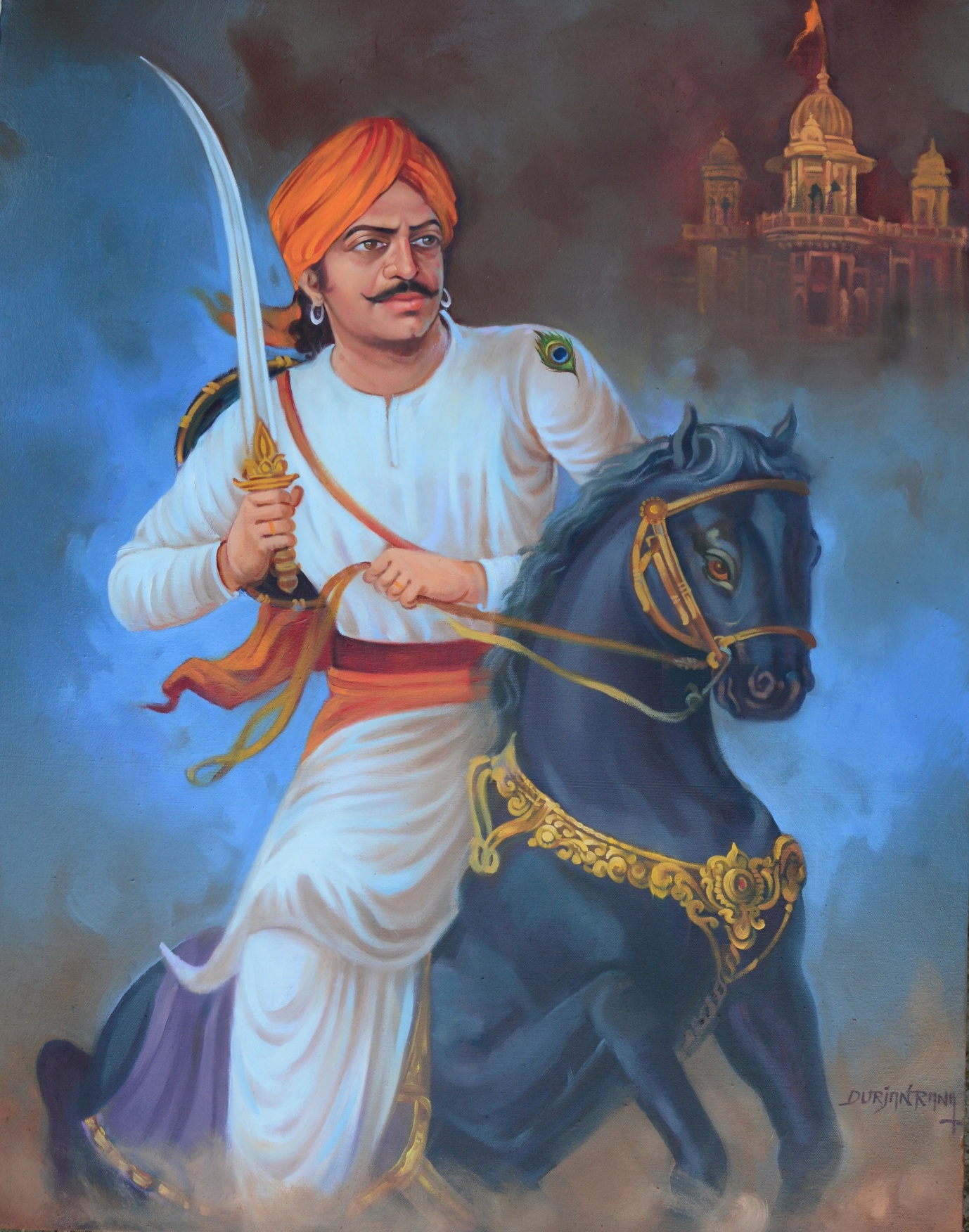Gokul Singh or Gokula Singh was a hindu Jat chieftain of Tilpat . His father’s name was Madu Singh. Madu Singh had four sons namely, Sindhuraj Singh, Ola Singh, Jhaman Singh and Saman Singh. The second son “Ola Singh” later became famous as Gokula Singh. As per some sources he was born in 1630s.
- Background Of Jat Rebellion: Aurangzeb and his bigotry
The sixth Mughal emperor i.e. Aurangzeb ascended to the throne of Delhi on 21 July 1658. He imprisoned his father Shah Jahan (5th Mughal Emperor) at the Agra fort. During his reign which starts from 1658 CE to 1707 CE Aurangzeb fought many battles with the Hindu kings who were fighting for their independence.
Initially, Aurangzeb passed his time in northern India with the aim of strengthening the military and administration of the Mughal Empire. But with the rise of the Maratha King i.e. Chhatrapati Shivaji Maharaj, Aurangzeb shifted his focus on suppressing the Marathas and Deccan region.
Alamgir (Aurangzeb) spent a huge portion of Mughal resources including military, his court, etc. on conquering Deccan. As a result of this botched attempt, the northern part of Hindustan became vulnerable and soon the peasants and even the upper class were now on the verge of facing an economic crisis. Different sections of people now decided to revolt against him.
Rebellion now became the only solution for the native (mostly Hindus). The first rebellion which broke out during Aurangzeb’s reign was led by a Champat Rai of Bundelkhand. But the rebellion was easily crushed by the Mughals and Champat Rai in the year of 1661 committed suicide.
At the same time, the emperor (Aurangzeb) decided to follow the path of expansionist policy for enlarging his empire. Furthermore, the emperor also initiated his plan to implement his religious policies. He believed in carrying holy war against Non-Muslims and converting their land to the realm of Islam. In the year 1659 CE several ordinances were issued by the emperor the establishment of Muslim Law due to this large section of Non-Muslims especially Hindus felt discriminated.
Alamgir forbade music in his court, banned the cultivation of bhang, drinking wine was prohibited and stopped the practice of gambling. To add insult to injury the bigot Mughal Emperor refused to repair the old temples and in the year 1699, he issued a strict order to demolish the temples and schools of the infidels (Non-Muslims).
The result of this draconian decision was terrifying for the Hindus. Countless temples were demolished including Visvanatha of Benaras, Keshav Dev at Mathura, and Somnath. In the land of Amber (at Jaipur) a total of 66 temples were destroyed.To spread Islam all over the Indian sub-continent Jizya a type of religious tax was re-imposed (in the year 1679 CE) which was formally banned by Akbar. Due to this many Hindus accepted Islam and Alamgir felt very proud of this. To further harass the helpless Hindus in the year 1668 CE all the Hindu Religious Affairs were banned. And at this time the Rajput rulers were completely enslaved to the Mughals and with this they had full support. so that their small princely states remain.
- Rise of Gokula Singh: The leader of the Jat Rebellion of 1669.
These decision of Alamgir boiled the Hindus to their brim and soon a tremendous spark of rebellion broke out under the leadership of Gokula Singh who belonged to the Jat community. In the year 1669 CE the Holy city of Mathura witness a tremendous rebellion. This was an armed insurrection led by Gokula Singh of Tilpat his uncle Chaudhari Uday Singh And his fellow Jat supporters. Most of the people who were supporting the Hindu hero (Gokla Singh) belonged to the peasantry community.
However not much is known about the early life of this brave Jat leader who revolted against the most powerful empire of the World. He (Gokla Singh) was the zamindar of Tilpat (located in present-day Haryana).
Note: Most of the members of this rebellion were from the Jat community but it is believed that it also consisted of people from Gurjar, Ahir, Rajput communities.
The mutineers assembled at Sahora village and they killed the faujdar of Mathura i.e. Abd un Nai on 12 May 1669 CE. Later they sacked the Pargana of Sadabad (situated 24 miles from Mathura). By now the wave of rebellion entered Agra and the Mughals became vulnerable. Enraged by this rebellion of the Jats Aurangzeb sent a strong army under the command of Radandaz Khan but this force of the Mughals was unsuccessful in suppressing the rebellion
The Mughal officials decided to offer terms and signed a peace agreement. But Gokula Singh refused and decided to continue his rebellion. Hasan Ali Khan who was the faujdar of Mathura was dispatched by the emperor to put a stop to Gokla’s activities. It is believed that a furious battle took place between the Jats and the forces of Hasan Ali and in which 300 rebels and many Mughals got killed.
Note: Prior to this battle Alamgir sent ShafShikha khan to cross swords with the Jats but this move was repulsed.
Later the emperor himself led the army to crush the rebellion of the Jats once and for all. By now the army of Gokla Singh assembled a Hindu army of about 20,000 brave Jats. But most of his soldiers were not regular troops and were no match in front of the Mughal army which had superior weapons, well equipped, and was controlling the whole of North India.
Both the armies crossed their sword at a place 20 miles from Tilpat and total carnage ensued. The Mughal artillery and muskets for a moment were felt completely useless in front of the veer (Brave) Jats.
But the trained and disciplined of the Mughal hordes won the day for the emperor. Although heavy losses were counted on both sides by evening the Jats who were fighting with swords and arrows decided to retreat to Tilpat. The Mughals chased them and laid a siege on Tilpat.
The Mughal siege continued for three days. The Jats continued their resistance for three days in front of Mughals who had artillery support. On the fourth day of the siege, the Mughals broke the Jat defense and entered inside the fort.
The Jats displayed their valor and killed many Mughal soldiers. But in the end, the Superior army of the Mughals came out victorious. However, the Mughals lost 4000 men while the Jats lost 5000, and 7000 were taken as prisoners. The rebellion was crushed and the leader of the insurrection
Death
After suppressing the rebellion for some time, Gokula Singh and his uncle Udai Singh were imprisoned.Jat women committed Jauhar. An offer was made to Gokula Singh by the Mughal emperor that his life would be spared if he accepted Islam. I will give them a huge jagir. But he did not accept Islam. And took the final decision to stay in his Hindu religion. After which, on the orders of the Mughal emperor,but on 1 January 1670 Gokula Singh and his uncle Uday Singh body started cutting into small pieces, brutally killing them and hanging them at the Kotwali of Agra. After that so that fear is created among the people and does not revolt again.But the rebellion didn’t finish here. Soon after some time, the Jats rose again and this time with more preparation under the leadership of Raja Ram Singh .
References :-
- नरेन्द्र सिंह वर्मा – वीरवर अमर ज्योति गोकुल सिंह, संकल्प प्रकाशन, आगरा, 1986, पृष्ट 6
- R.C. Majumdar, H.C. Raychaudhari, KalikinkarDatta: An Advanced History of India, 2006, p.490
- डा. धर्मभानु श्रीवास्तव, The Province of Agra (Concept Publishing Company, New Delhi) pp7-8


